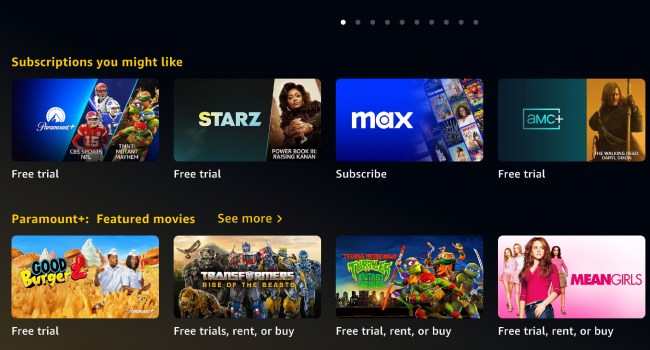
Honestly, it’s what cable or satellite with a DVR was like once upon a time, or at least the good parts of cable.
The trouble is, some of the streamers don’t want to cooperate, and no single platform has universally emerged to unify everyone. Amazon Prime Video, however, is making the case that, hey, maybe it should be us.
At an industry event Amazon hosted on Wednesday, June 25 in Culver City, CA called Engage 2025, the research firm Antenna presented data from a study commissioned by Amazon about overall streaming growth and the value of making subscription streaming content available through third party distribution. Prime Video already has over 800 partner channels (now referred to as “subscriptions” by Amazon), including other rival SVOD services and FAST channels.
Yet another one was just announced to be launching yesterday, Jon Erwin’s Wonder Project, which will release season two of “House of David” to its subscribers early before other Prime Video subscribers can watch it.
But while Wonder Project and others like PBS are only available as a subscription through Prime Video, other streamers that are otherwise available directly through their respective apps are also available to subscribe to through Prime Video, including most notably HBO Max, Paramount+, Apple TV+, Crunchyroll, and many others.
For those four specific services, Antenna modeled just how many more incremental subscribers they have received by being available on Prime Video versus if they weren’t. Antenna found that in aggregate, streamers saw an additional 5.6 million signups, an increase of 89 percent, that wouldn’t have occurred off of Prime Video Channels.
Antenna built its model and came to that number by looking at what actually happened for HBO Max after it ended its distribution partnership with Prime Video in 2021 but then came back in 2022. It first lost 5.1 million subscribers, as people who watched HBO Max shows through Prime didn’t all immediately come over to HBO Max directly. When HBO Max came back to Prime Video, so did subscribers, with the service gaining 3 million signups in the first three months back on the platform. Antenna’s model projects that being on Prime Video saved Apple TV+ an additional 1.5 million subs, Crunchyroll an additional .4 million, and Paramount+ an extra 1.5 million.
Amazon is presenting all this data because it wants to be that one stop shop for all the streamers combined, all the better to get them to buy interactive ads during their shows and movies. Amazon in particular is unique in that its platform has AI that can detect what you’re seeing on screen and suggest to add that item directly to your Amazon cart. Synergy and whatnot.
But, so far, every streamer’s strategy has been different for how they approach third party distribution. Paramount+ gets their subscriptions from all sorts of places, including directly via Paramount+ but also through Prime Video Channels, the Roku Channel, YouTube TV, and as add-ons via the app stores for Amazon Fire TV, Google Play, Roku, and iTunes.
Peacock, by comparison, isn’t on Prime Video or channels via other platforms, but is something you can buy through various app stores. Apple TV+ only just added access through Prime Video, making it the only other place you can buy it if not direct (Antenna estimates 9 percent of its overall subscriptions come from Prime Video). And Netflix is purely direct-to-consumer, meaning the only way to watch Netflix content is to go to them directly.
So what does all this mean? Netflix and others like Disney+ are unlikely to start playing ball any time soon. Disney is building its own bundles to keep you in its own ecosystem, and Netflix’s means of growth has been to license more stuff and also look to live events to attract a new audience, but it has no interest in being the home to other platforms other than its own.
But it could lead other services to expand their third party access over time, and that could have an impact on whether all of these individual streamers even survive in the long run.
Discover more from imd369
Subscribe to get the latest posts sent to your email.


